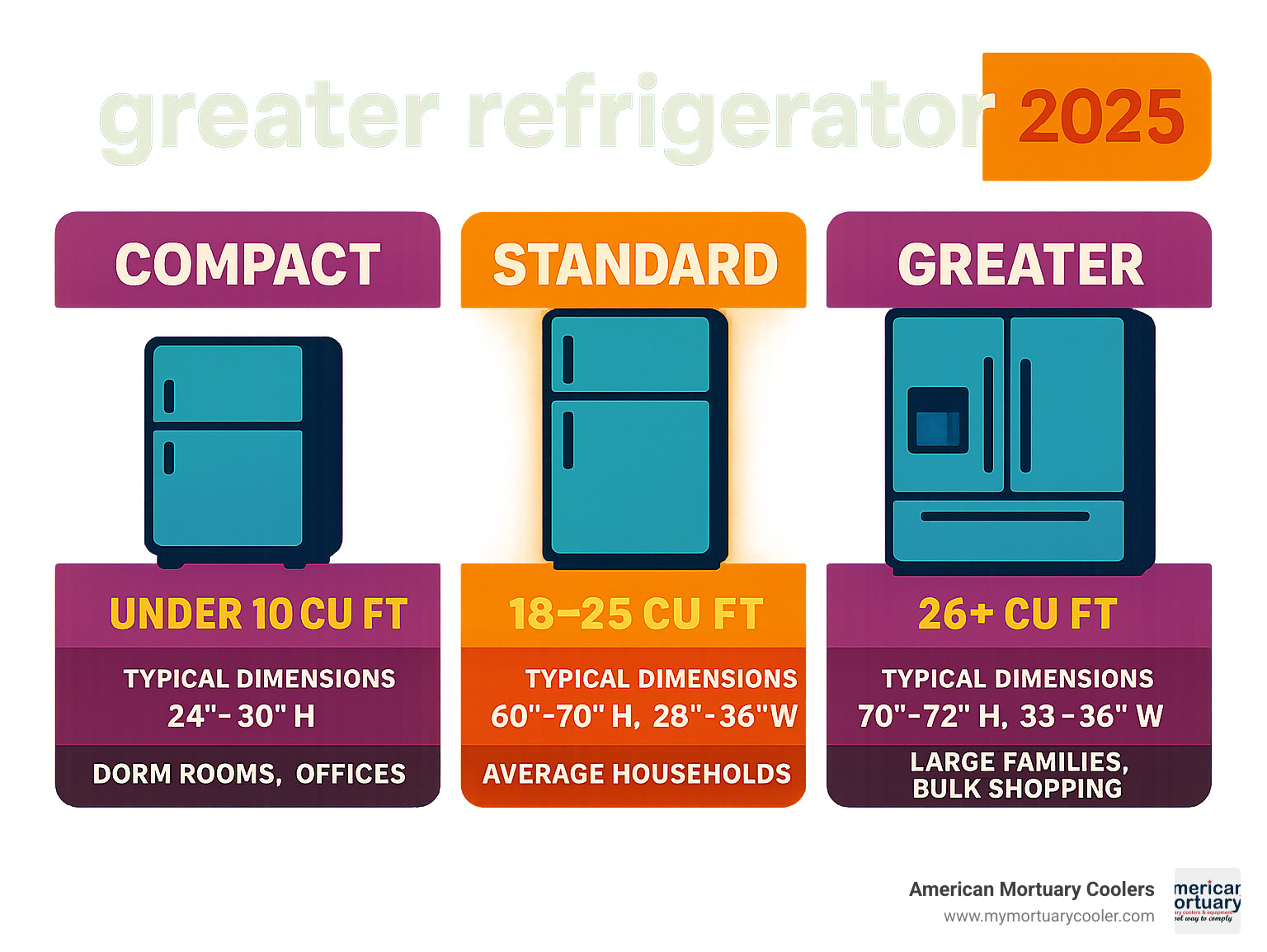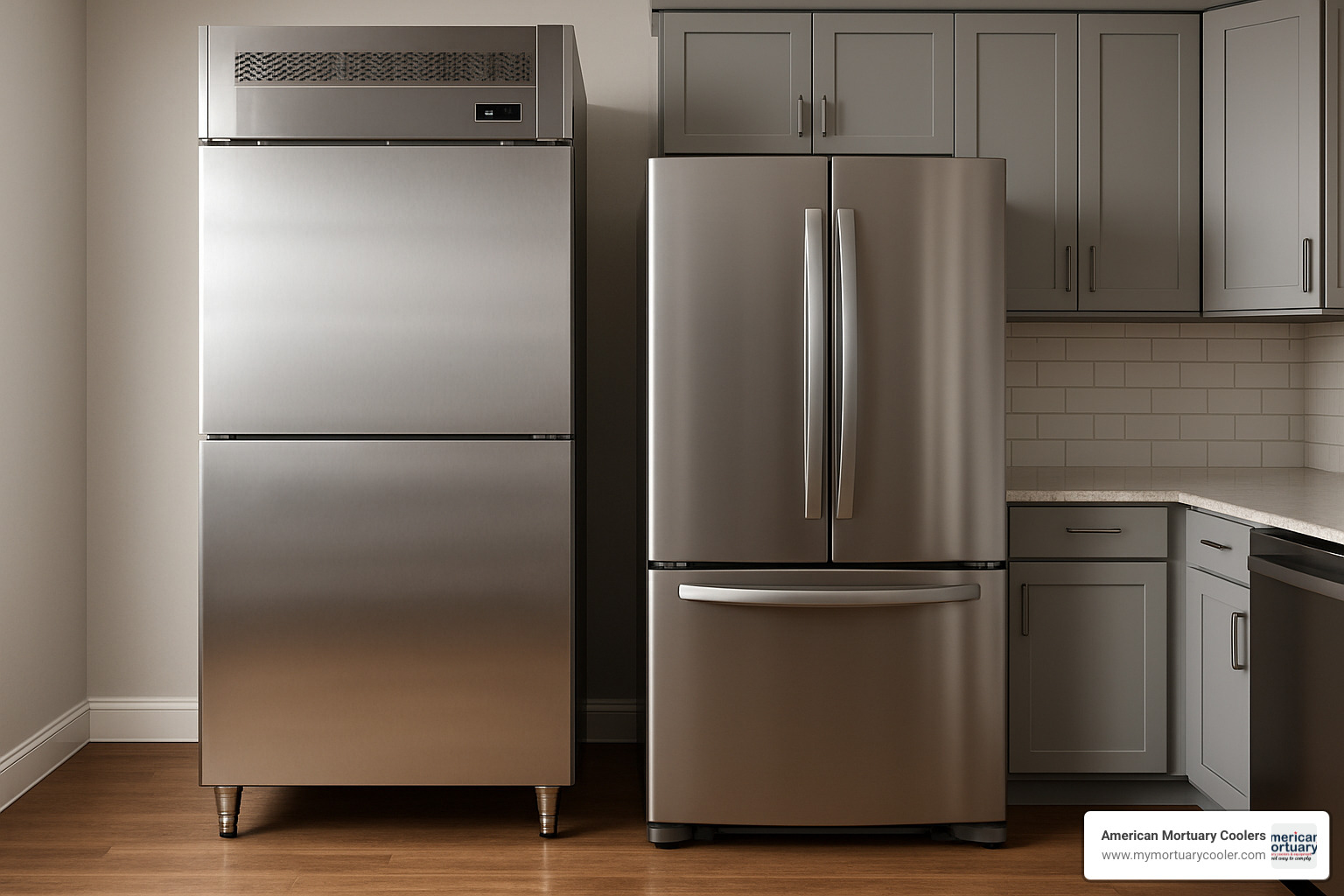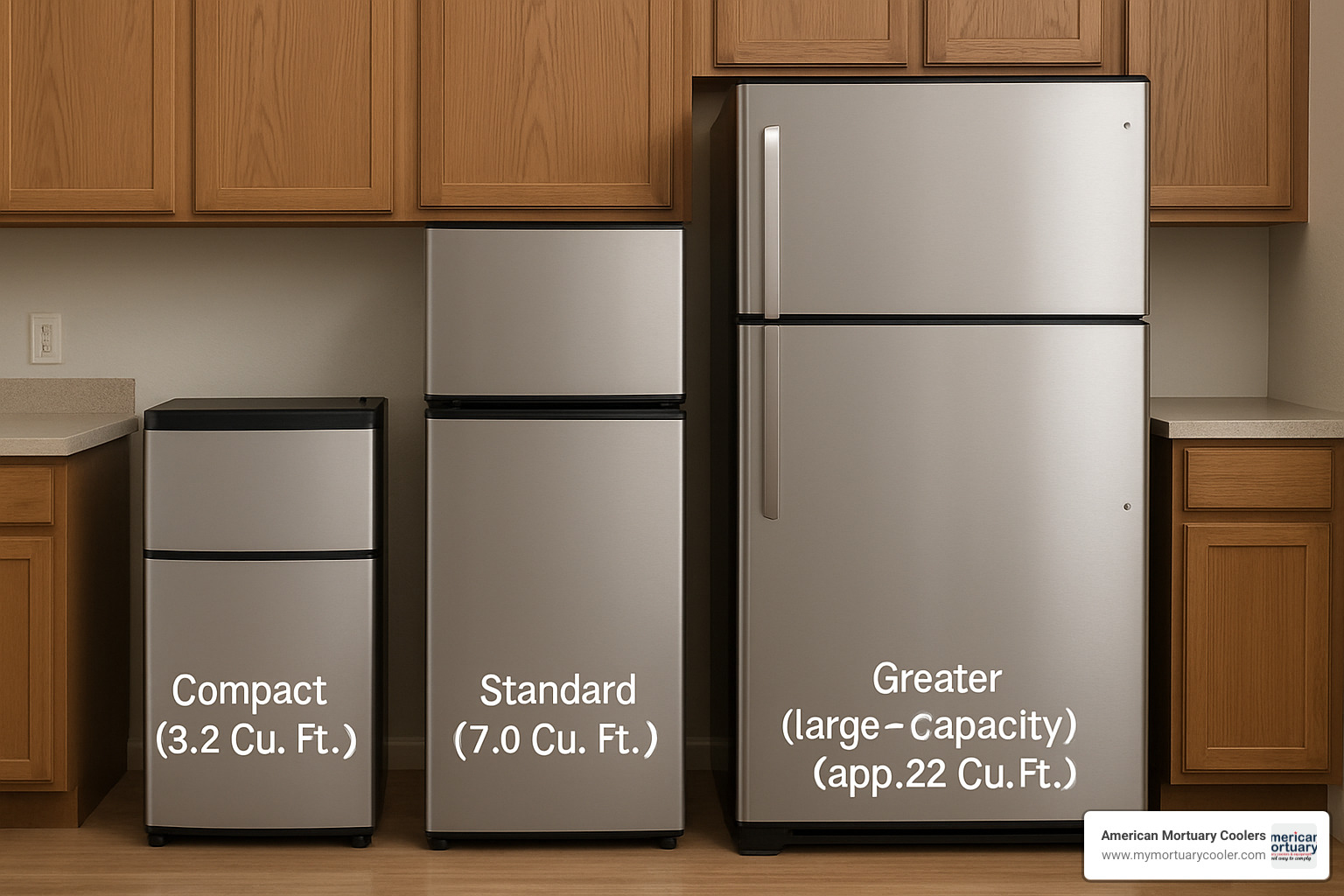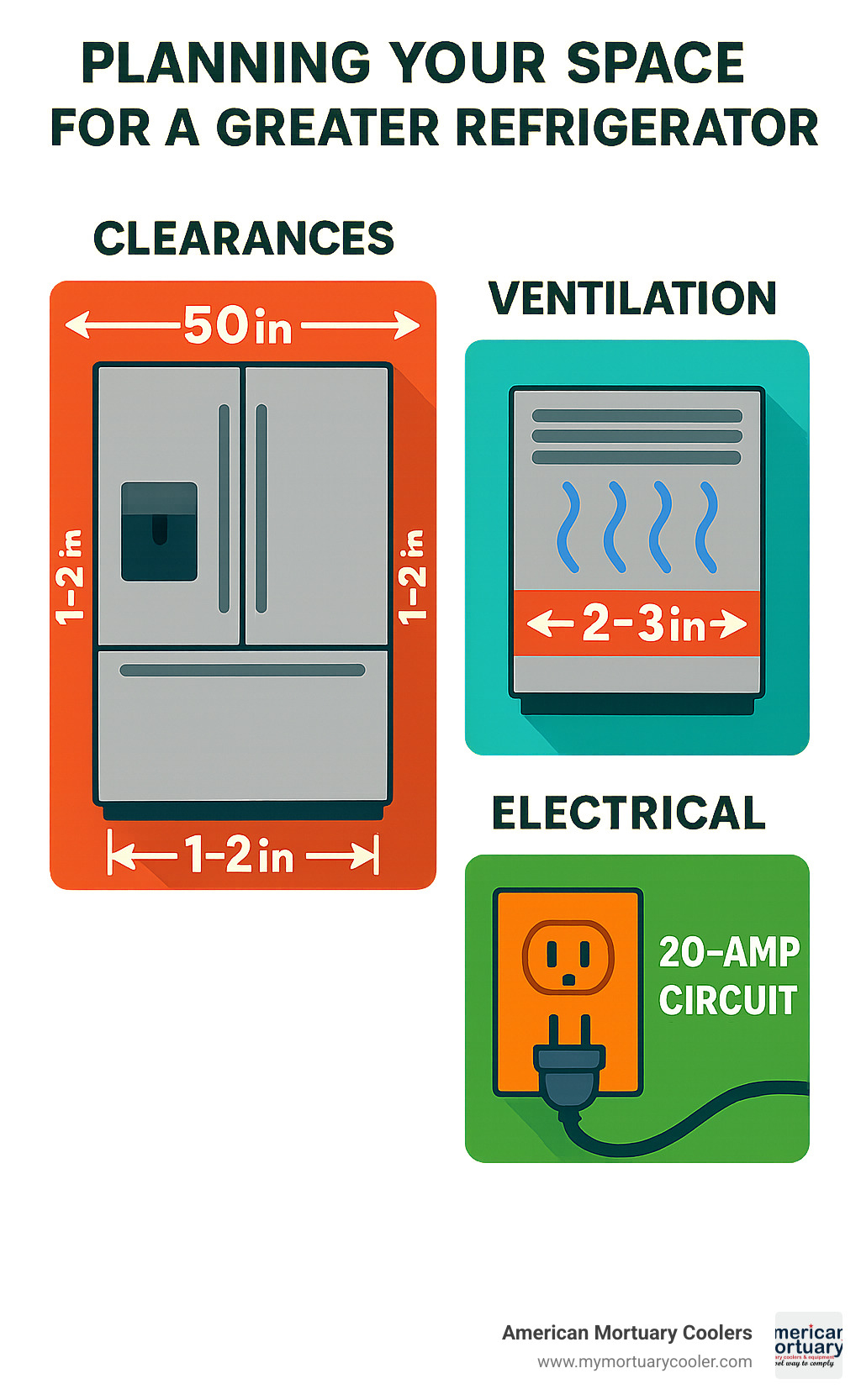Why a Greater Refrigerator Could Transform Your Space
A greater refrigerator is defined as any refrigeration unit with 26.7 cubic feet or more of storage capacity, typically measuring 33-36 inches deep and 70-72 inches tall. These large-capacity units offer significantly more storage than standard models while incorporating advanced features like dual ice makers, smart connectivity, and specialized temperature zones.
Key specifications for greater refrigerators:
- Residential models: 26.7-30.7 cu ft capacity
- Commercial reach-in units: 47-49 cu ft capacity
- Dimensions: Over 42 inches wide, 70+ inches tall
- Popular styles: French door, side-by-side, counter-depth
- Price range: $1,800-$4,500 residential, $2,500-$7,000 commercial
The jump from a standard 18-22 cubic foot refrigerator to a greater refrigerator means 40-60% more storage space. This translates to fewer grocery trips, reduced food waste from better organization, and the ability to buy in bulk. Commercial establishments benefit even more dramatically - a 47 cubic foot reach-in unit provides over 50% more capacity than the largest residential models.
Whether you're managing a busy household of five or more, running a small business, or simply prefer the convenience of bulk shopping, understanding your options in the greater refrigerator category can save both time and money in the long run.
As specialists at American Mortuary Coolers, we've spent years helping funeral home directors and business owners select large-capacity refrigeration solutions that meet specific space and durability requirements.

Why Bigger Matters
When we talk to clients about upgrading to a greater refrigerator, the benefits become clear almost immediately. Food waste reduction is perhaps the most compelling advantage - with proper organization zones and ample space, families report throwing away 25-30% less food simply because items don't get lost in the back of cramped shelves.
Weekly grocery runs become more strategic rather than reactive. Instead of multiple trips for forgotten items, you can stock up on sale items and bulk purchases from warehouse stores. This is especially valuable for families with teenagers or households that do a lot of home cooking and meal prep.
How This Guide Is Organized
We've structured this guide to take you from understanding basic capacity classifications all the way through installation and long-term maintenance. You'll find practical shopping checklists, detailed comparison tables, and maintenance tips that we've learned from years of working with large-capacity refrigeration systems.
Understanding Greater Refrigerator Capacities & Types
Shopping for a greater refrigerator can feel overwhelming when you're faced with dozens of models and configurations. The good news? Once you understand the basic categories, finding the right fit becomes much clearer.
Most residential greater refrigerators fall between 26 and 30 cubic feet. That's a substantial jump from the 18-22 cubic foot models most people are used to. French door models dominate this space because they make sense - you get that wide refrigerator compartment up top for your daily items, plus easy access to the freezer below.
Side-by-side models still have their fans, especially in tighter kitchens where you can't swing those big French doors open. These typically offer the most freezer space relative to their size, which is perfect if you're the type who meal preps on Sundays or stocks up during sales.
Then there's the commercial world, where commercial reach-in units can hit 47 to 49 cubic feet - that's nearly double the capacity of large home models. These aren't just for restaurants anymore. We're seeing more homeowners with serious cooking habits investing in commercial-grade units for their kitchens.
| Refrigerator Type | Capacity Range | Typical Width | Best For |
|---|---|---|---|
| Residential French Door | 26-30 cu ft | 33-36 inches | Large families, home chefs |
| Residential Side-by-Side | 26-28 cu ft | 35-36 inches | Narrow kitchens, freezer-heavy users |
| Commercial Reach-In | 47-49 cu ft | 42+ inches | Small businesses, serious home cooks |
What Qualifies as a Greater Refrigerator?
A greater refrigerator starts at 26.7 cubic feet of total capacity. That might seem like an oddly precise number, but it represents the point where you're getting meaningfully more space than standard models.
Size-wise, these units typically measure 70 to 72 inches tall and 33 to 36 inches deep. The width varies the most - you'll find models ranging from just over 33 inches for compact French door units up to 48+ inches for commercial reach-in models.
The 42-inch width mark is where things get serious. Once you're looking at units this wide, you're in commercial territory or dealing with premium residential models that need special planning for delivery and installation.
Popular Greater Refrigerator Styles for Homes and Businesses
French door models own the residential greater refrigerator market, and for good reason. That wide top compartment is perfect for party platters, large casserole dishes, or just being able to see everything at once. Samsung and LG are leading the pack here, with models consistently earning 4.5+ star ratings from customers.
Counter-depth models deserve special attention if you want that built-in look without the custom price tag. LG's Counter-Depth MAX series manages to squeeze 24 cubic feet into a unit that sits nearly flush with your cabinets.
For commercial applications, reach-in merchandisers and walk-in prep units represent the ultimate in both capacity and durability. If you're curious about the full range of commercial options, our Ultimate Guide: Cooler Units covers everything from basic reach-ins to walk-in coolers.
At American Mortuary Coolers, we see the commercial side of this market daily. The reliability and capacity of these larger units make them essential for businesses that can't afford downtime or temperature fluctuations.

Key Features to Look for in a Greater Refrigerator
When you're investing in a greater refrigerator, you're not just buying more space – you're getting access to features that can genuinely change how you store and organize food.
Smart Wi-Fi connectivity has moved from luxury to necessity in most premium models. You can check your refrigerator's temperature from your phone, get alerts when the door's been left open, and even peek inside through built-in cameras while you're at the grocery store.
Storage zones are where greater refrigerators really shine. Convertible drawers can switch between refrigerator and freezer temperatures with the touch of a button – perfect for holiday prep when you need extra freezer space, or summer when you want more room for fresh produce.
Dual ice makers have become almost expected in this category. Some models offer both regular cubes and specialty ice like LG's Craft Ice spheres. The Slim SpacePlus Ice System is particularly clever – it maximizes shelf space while still churning out plenty of ice.
ENERGY STAR certification isn't just a nice-to-have sticker when you're dealing with a greater refrigerator. These larger units naturally use more power, so efficiency features like linear compressor technology and inverter controls make a real difference on your electric bill. The Complete Guide to Fridge Compressor Function and Operation explains how modern compressor technology keeps your unit running efficiently while lasting longer.
Door-in-door features might seem gimmicky, but they actually help maintain temperature by letting you grab frequently used items without opening the main compartment. And anti-smudge finishes, especially fingerprint-resistant stainless steel, are essential unless you enjoy constantly wiping down your refrigerator.
Don't overlook the door gasket – that rubber seal around the door edges. Scientific research on door-gasket efficiency shows that a properly functioning gasket significantly impacts both energy consumption and how well your food stays fresh.
Space-Saving Innovations Inside a Greater Refrigerator
Greater refrigerators get really clever with space maximization. Thin door construction is a game-changer. LG's doors are just 2.2 inches thick – that's 45% thinner than older models. Those saved inches add up to significantly more storage space inside.
Zero-clearance hinge systems solve a common installation headache. You can install your greater refrigerator nearly flush against cabinetry while still getting full door opening.
Slide-away shelves and fully adjustable configurations let you customize the interior for whatever you're storing. Gallon door bins are sturdy enough to hold large containers without wobbling every time you open the door.
Sustainability & Running Costs
A greater refrigerator will use more electricity than a smaller model, but modern efficiency improvements have largely offset the capacity increases.
ENERGY STAR certified models use advanced insulation and variable-speed compressors that adjust their power based on actual cooling needs. Inverter technology allows the compressor to run at just the right speed for current conditions, meaning more consistent temperatures and lower energy consumption.
Many utility companies offer rebates for ENERGY STAR certified appliances, which can help offset the initial cost. The eco-friendly refrigerants used in modern units are better for the environment and often more efficient at maintaining consistent temperatures.
Comparing Greater vs. Standard vs. Compact Refrigerators
When you're standing in the appliance store trying to decide between sizes, the numbers can feel overwhelming. Let's break it down in a way that actually makes sense for your daily life.
The capacity gain from a standard 20 cubic foot refrigerator to a 28 cubic foot greater refrigerator gives you 40% more storage space. That's like adding an entire extra refrigerator compartment to your kitchen. For many families, this translates to going from cramming groceries into every available corner to actually having room for that leftover birthday cake.
Upfront costs tell an interesting story. Standard refrigerators in the 18-22 cubic foot range typically cost $800-$2,000, while greater refrigerators start around $1,800 and can reach $4,500 for premium residential models. Yes, you're paying more upfront, but the cost per cubic foot often works out to be similar or even better with larger units.
Commercial reach-in units represent the top tier, ranging from $2,500-$7,000. These aren't just bigger - they're built for constant use and precise temperature control that most homes don't need.
Here's something that might surprise you: energy consumption doesn't double when capacity doubles. A 28 cubic foot greater refrigerator typically uses only 15-20% more energy annually than a 20 cubic foot model. Better insulation and more efficient compressors in newer large models help keep your electric bill reasonable.
Installation clearance requirements are pretty similar across sizes for side and rear spacing. The main difference is height - those 72+ inch greater refrigerators need adequate ceiling clearance, and you'll want to measure your delivery path carefully.
Reliability ratings from consumer reports show that larger models from established manufacturers like Samsung, LG, and Whirlpool maintain similar reliability scores to their smaller counterparts. The increased complexity doesn't seem to hurt long-term durability when you stick with quality brands.

When a Greater Refrigerator Is Worth the Investment
A greater refrigerator starts making real sense when your current fridge feels like a puzzle every time you grocery shop. Families of five or more almost always benefit from the upgrade - there's just no getting around the math of feeding that many people regularly.
Home chefs who love to meal prep or entertain frequently find the extra space transformative. When you can actually fit multiple sheet pans of prepped ingredients or store a whole turkey without rearranging everything else, cooking becomes more enjoyable and less stressful.
Small business owners in catering or foodservice often find that a residential greater refrigerator offers better value than commercial units for lower-volume needs. The advanced features and energy efficiency can actually save money over time through reduced operating costs.
Most families hit their break-even point around 18-24 months when they take advantage of bulk buying opportunities and waste less food through better organization.
Budget Breakdown & Typical Price Ranges
Let's talk real numbers for residential greater refrigerators. Entry-level models from reliable brands like Frigidaire or Whirlpool start around $1,800-$2,200 for basic 26-27 cubic foot capacity. These give you the space without all the bells and whistles.
Mid-range options from Samsung, LG, and KitchenAid typically run $2,500-$3,500 and include smart features, dual ice makers, and premium finishes. This range represents the sweet spot for most households wanting a greater refrigerator - you get great value without paying for features you'll never use.
Premium models with internal cameras, voice control, and specialized storage zones can reach $4,000-$4,500. These are impressive, but honestly, most families are perfectly happy with mid-range features.
Commercial reach-in units designed for foodservice applications range from $2,500-$7,000 depending on capacity and construction quality. These make sense for serious commercial use but are overkill for most home applications.
Financing options are widely available through retailers and manufacturers, with 0% interest promotions common for qualified buyers. The Refrigerators – The Home Depot selection shows the current range of available options and pricing, making it easy to compare your choices side by side.
Installation, Energy & Maintenance Considerations
Getting a greater refrigerator into your home and running smoothly requires more thought than you might expect. A little planning upfront saves you headaches later.
Your new greater refrigerator needs room to breathe. Most manufacturers want 1-2 inches on each side and 2-3 inches at the rear for proper airflow. Skip this step, and your refrigerator will work harder, use more energy, and likely break down sooner.
Door swing clearance catches many people off guard. That beautiful 36-inch wide French door model? It needs about 50 inches of clearance when both doors are fully open. Side-by-side models are more forgiving here.
Most greater refrigerators need a dedicated 20-amp circuit, though some commercial-style units bump that up to 30 amps. Your electrician should install a delayed-trip breaker rated at 120% of the unit's full-load amperage.
Maintenance becomes more critical with larger units simply because there's more at stake. Annual coil cleaning, gasket checks, and filter replacements help maintain peak efficiency. A Comprehensive Guide to Refrigeration Units and How They Work walks through detailed maintenance procedures that can extend your unit's lifespan significantly.

Planning Your Space for a Greater Refrigerator
Most residential greater refrigerators weigh between 250-350 pounds empty, which sounds intimidating but rarely requires floor reinforcement. Standard home construction handles this weight easily. Commercial units are different - if you're considering one of those massive reach-in models, a structural engineer's opinion might be worth the consultation fee.
The real challenge is getting your greater refrigerator from the truck to its final home. We've seen too many delivery disasters that could have been avoided with a tape measure and five minutes of planning.
Measure everything twice. Every doorway, hallway width, and ceiling height between your front door and the kitchen. Standard residential doorways run 32-36 inches wide, which gets tight when you're moving a 35+ inch refrigerator.
The 90-degree turn radius is often the deal-breaker. A unit that fits through doorways might not steer that corner where your hallway meets the kitchen. Sometimes threshold removal is necessary for the largest models.
Keeping Your Greater Refrigerator Running Efficiently
Your greater refrigerator is a significant investment, so keeping it running smoothly makes financial sense. Modern units are pretty low-maintenance if you stay on top of a few key tasks.
Condenser coil cleaning tops the list. Those coils, usually on the back or bottom of your unit, collect dust, pet hair, and whatever else floats around your kitchen. Clean them every 6-12 months depending on your environment.
Smart connectivity has revolutionized maintenance alerts. LG's ThinQ and Samsung's SmartThings apps can tell you when filters need replacement or when temperature patterns suggest trouble brewing.
Professional tune-ups every 2-3 years might seem like overkill, but they're cost-effective insurance. A technician can spot worn gaskets, refrigerant leaks, or compressor issues before they become expensive problems.
At American Mortuary Coolers, we've learned that consistent maintenance is the difference between equipment that lasts 10 years and equipment that serves reliably for 20+ years.
Frequently Asked Questions about Greater Refrigerators
When you're considering investing in a greater refrigerator, you probably have some practical questions bouncing around in your head. We've helped countless clients steer these decisions over the years, and the same concerns come up time and again. Let's tackle the big ones head-on.
How much energy does a greater refrigerator use per year?
Here's the honest truth about energy costs - yes, a greater refrigerator will use more electricity than your current standard model, but probably not as much as you'd expect. ENERGY STAR certified models in the 26-30 cubic foot range typically consume between 400-600 kWh annually.
To put that in perspective, a standard 18-22 cubic foot refrigerator uses about 300-450 kWh per year. So you're looking at roughly $15-30 more annually in electricity costs at the national average rate of $0.12 per kWh.
The real kicker? Most families find they actually save money overall. The bulk buying opportunities and dramatic reduction in food waste that comes with better organization often more than offset that modest increase in energy costs.
Commercial reach-in units are a different story entirely - they'll consume 1,200-2,000 kWh annually. But these workhorses are built for constant use and frequent door openings that would make a residential unit work overtime.
Can I fit a greater refrigerator through a standard 36-inch doorway?
This question gives us flashbacks to some interesting delivery days! Most residential greater refrigerators are specifically designed to squeeze through standard 36-inch doorways, but it's often tighter than threading a needle.
The unit itself might measure 33-36 inches wide, which sounds like it should fit easily. But here's the catch - those door handles can add an extra 2-3 inches to the effective width. Some manufacturers make removable handles specifically for delivery, while others... well, let's just say it requires some creative maneuvering.
Professional delivery teams have seen it all and come equipped with specialized dollies, protective padding, and occasionally a few choice words. The height clearance through doorways is rarely the problem since most greater refrigerators are designed to fit comfortably under standard 8-foot ceilings.
Our advice? Measure twice, order once. And maybe clear a path through your house while you're at it.
What are common complaints and how can they be fixed?
After years in the refrigeration business, we've heard every complaint in the book. The good news is that most issues have straightforward solutions.
Higher than expected energy bills top the complaint list. Nine times out of ten, this boils down to poor door seals, dirty condenser coils, or someone setting the temperature too low. A quick maintenance check and proper temperature settings (37°F for the fridge, 0°F for the freezer) usually solve this problem.
Ice maker headaches come in second, especially with those fancy dual ice maker systems. Before you panic, check your water filter first - a clogged filter causes most ice maker problems. Water pressure issues are the other usual suspect. Following the manufacturer's maintenance schedule religiously prevents most of these frustrations.
Temperature hot spots or inconsistency complaints usually mean one thing - the greater refrigerator is packed too full. We get it, all that space is tempting! But blocking the air vents with too much food creates circulation problems. Give your food some breathing room, and the temperature issues typically disappear.
The bottom line? Most complaints stem from maintenance issues or user habits rather than fundamental problems with the appliance itself. A little TLC goes a long way with these investment-grade units.
Conclusion & Next Steps
After diving deep into greater refrigerators, you're now equipped with everything you need to make a smart decision. The jump from a standard 18-22 cubic foot model to a 26+ cubic foot unit isn't just about size – it's about changing how you store food, plan meals, and manage your household or business.
The sweet spot for most families lies in the 27-28 cubic foot range with French door configuration. You'll get that wide refrigerator compartment that actually fits a pizza box, plus the energy efficiency that keeps your utility bills reasonable. For commercial applications, those 47-49 cubic foot reach-in units offer the durability and capacity that busy kitchens demand.
Custom fit matters more than you might think. We've seen too many people fall in love with a beautiful refrigerator online, only to find it won't fit through their kitchen doorway or requires electrical work they hadn't budgeted for. Measure twice, buy once – especially when you're investing $2,000 to $4,500 in a quality unit.
The durability factor becomes crucial when you're dealing with larger, more complex systems. That's why sticking with established manufacturers like Samsung, LG, or Whirlpool makes sense. Their service networks and parts availability give you peace of mind for years down the road.
Value isn't just about the sticker price. When you factor in reduced food waste, fewer grocery trips, and the ability to take advantage of bulk buying opportunities, most families see their greater refrigerator pay for itself within two years.
At American Mortuary Coolers, our expertise runs deep in specialized refrigeration solutions. While our primary focus serves funeral homes and mortuaries across the contiguous 48 states, the principles we've learned about durability, precise temperature control, and reliable operation apply whether you're preserving food or serving families during their most difficult times.
Your next steps are straightforward: Start with accurate measurements of your space, including door clearances and ceiling height. Set a realistic budget that includes installation and any electrical work. Then focus on the features that matter most to your situation – smart connectivity for tech-savvy families, maximum freezer space for bulk shoppers, or commercial-grade construction for business use.
For those considering even larger capacity solutions beyond traditional refrigerator formats, Everything You Need to Know About Walk-In Coolers for Sale explores options that might surprise you with their versatility and value.
Your greater refrigerator investment should improve your daily life while delivering the reliability you expect from a premium appliance. With proper selection, installation, and maintenance, these units provide exceptional performance that makes every trip to the kitchen a little more pleasant.


















